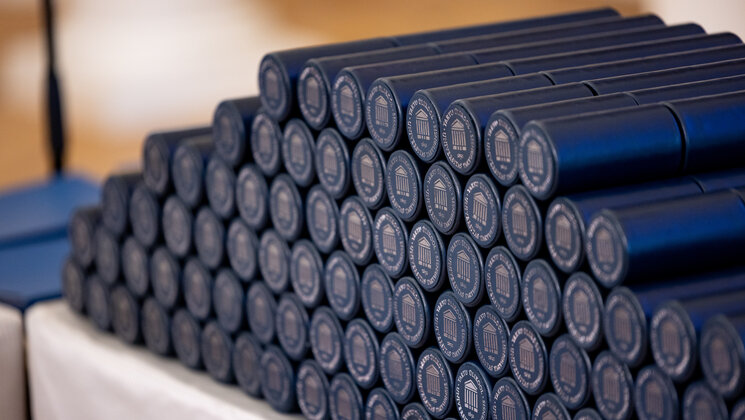IMCB in-house seminars: spring 2023

In-house seminars of the Institute of Molecular and Cell Biology of UT introduce the scientific research of the institute's various working groups in more detail. The seminars are open to everybody and, of course, in addition to the research staff of IMCB and neighboring institutes, students are also welcome.
Attention! This is the 2023 SPRING seminars page.
The 2023 AUTUMN SEMINARS page can be found on IMCB's website.
The seminars take place over one week on Thursdays at 15:00 in the auditorium 105 of the Omicum building (address: Riia 23b/2, Tartu). The working language of the seminars is English. The length of the seminar presentation is 35-45 minutes. Additional 15 minutes have been allocated for questions and discussion. Hopefully, this will be followed by an informal session where the speakers will have more time to find answers to any question asked by seminar attenders. The seminars will not be streamed online or recorded.
Spring seminars 2023:
February 16, time 15:00 - Hedvig Tamman:
„Activation of bacterial immune system by a viral capsid protein“
March 2, time 15:00 - Priit Jõers:
„Metabolic programming by predator (psychological) stress"
Summary: Predator stress is a chronic form of stress elicitated by constant presence of predators. The biochemical and behavioral changes caused by predator stress are very similar to human psychological disorders such as anxiety and depression. By characterizing alterations induced by predator stress in Drosophila, we have discovered that diabetes-like reprogramming of metabolism, involving inactivation of Akt kinase and signaling by serotonin. We report the first direct evidence how depression-like states can cause metabolic deficiency in animals and provide explanation for such (mal)adaptive changes.
March 16, time 15:00 - Osamu Shimmi
Title: „Interplanar Amida Network: An intercellular network supporting 3D morphogenesis"
Summary: Comprehensive analysis of cellular dynamics is fundamental to animal development during the process of morphogenesis. Despite recent advancements in light microscopy, how successive cell shape changes lead to 3D morphogenesis has yet to be fully understood. In this study, we used in vivo live imaging of Drosophila wing development to investigate unique cellular structures comprising a membrane protrusion network: the Interplanar Amida Network (IPAN). The IPAN initially sustains cell-cell contacts between two wing epithelia through basal protrusions. The subsequent programmed disassembly of the IPAN involves the loss of these contacts, which are required for tissue proliferation both autonomously and non-autonomously. Furthermore, intercellular trafficking via membrane protrusions provides a unique framework for tissue morphogenesis. In this talk, I will discuss our ongoing projects and future plans.
March 30, time 15:00 Jaanus Remme and Aivar Liiv
"How rRNA modifications change the ribosome?"
Summary: All known ribosomal RNA species have post-transcriptional modifications around the ribosome functional centers. In spite of that, functional importance of the rRNA modifications has remained enigmatic. We describe our approach to define possible functional roles of the rRNA modifications at molecular level.
April 13, time 15:00 Tõnis Org
"Generation of induced pluripotent stem cells for functional studies"
Summary: To study molecular mechanisms of cellular processes, live cells of particular type are needed. I will talk about our attempts to create induced pluripotent stem cells, that can be differentiated into desired cell-type and used for functional studies.
April 27, time 15:00 Priit Väljamäe (Cellulose research group)
Title: H2O2 COSUBSTRATE IS A DOUBLE-EDGED SWORD FOR LYTIC POLYSACCHARIDE MONOOXYGENASES (LPMOs)
Summary:
Because of their ability to break glycosidic bonds in recalcitrant polysaccharides like cellulose and chitin, the catalysis by lytic polysaccharide monooxygenases (LPMOs) is of major interest. These monocopper enzymes depend on the H2O2 cosubstrate and the presence of the reductant. In polysaccharide peroxygenase reaction the H2O2 is consumed stoichiometrically with glycosidic bond cleavage, while reductant is needed only for initial “priming” of LPMO-Cu(II) resting state to its catalytically active LPMO-Cu(I) form. However, polysaccharide free LPMO-Cu(I) is amenable to reoxidation by O2 (reductant oxidase reaction) and H2O2 (reductant peroxidase reaction). Unfortunately, the reoxidation by H2O2 may lead to the irreversible inactivation of the enzyme. This unwanted side reaction is a major drawback in industrial application of these powerful enzymes. During last 5 years we have performed kinetic characterization of the H2O2-driven catalysis by multiple LPMOs of both bacterial and fungal origin. On the applied side of LPMO science, we have shown that enzyme-independent redox reactions in industrially relevant streams of lignocellulose biorefining may lead to the accumulation of H2O2 to the levels that are detrimental for LPMOs. We hope that an in-depth understanding of the kinetics of different LPMO catalyzed reactions along with the enzyme-independent reactions that influence the dynamics of H2O2, helps knowledge-based adjusting of the reaction conditions for optimal stability of LPMOs.
May 11, time 15:00 Jaak Truu
Title: „Impact of silver nanoparticles on biofilm and antibiotic resistome in wastewater treatment“
Summary: Silver nanoparticles (AgNP) are among the most prevalent engineered nanomaterials that enter wastewater during their production, usage, and disposal phases. Understanding the effects of AgNPs on microbial community structure, abundance, and removal efficiency of pathogens and antibiotic resistance genes (ARGs) in wastewater treatment facilities, including constructed wetlands, is vital for public health. We assessed the impact of increased AgNP and Ag+ ion concentrations on microbial community composition, treatment efficiency, and ARG removal in a pilot-scale hybrid wastewater treatment system. Our study revealed that elevated levels of AgNPs and Ag+ ions had a moderate effect on the prokaryotic community composition in the filter material biofilms and did not significantly impact the system's purification efficiency. However, higher Ag concentrations did influence the abundance and removal efficiency of ARGs in the wastewater, leading to increased ARG discharge into the environment. We observed a rise in relative abundance values for tetracycline, sulfonamide, and aminoglycoside resistance genes, as well as elevated levels of plasmid and integron-integrase genes in the biofilms of the AgNP-treated system. These findings suggest that further research is necessary to comprehend the effects of AgNPs on the nature and characteristics of prominent resistance genes in wastewater treatment systems.






